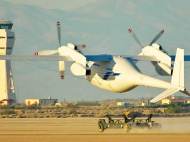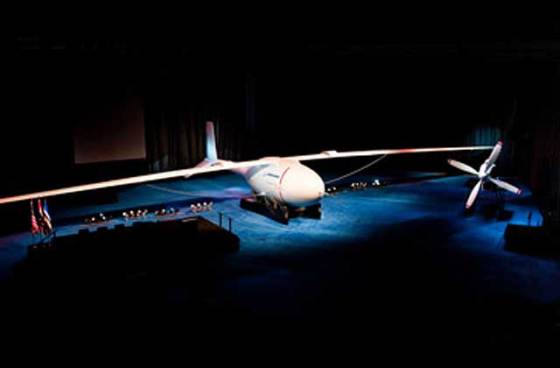Boeing Phantom Eye – liquid-hydrogen powered UAV
 Nearly two years after it has been revealed to the public during a ceremony in St. Louis, Boeing recently revealed that their high-altitude, long-endurance (HALE) unmanned aerial vehicle (UAV) named Phantom Eye managed to complete its first take off and landing. Although its performance is still far from the goals set by Boeing, it does prove the viability of liquid-hydrogen powered UAVs.
Nearly two years after it has been revealed to the public during a ceremony in St. Louis, Boeing recently revealed that their high-altitude, long-endurance (HALE) unmanned aerial vehicle (UAV) named Phantom Eye managed to complete its first take off and landing. Although its performance is still far from the goals set by Boeing, it does prove the viability of liquid-hydrogen powered UAVs.
“This day ushers in a new era of persistent Intelligence, Surveillance and Reconnaissance (ISR) where an unmanned aircraft will remain on station for days at a time providing critical information and services”, said Darryl Davis, president of Phantom Works for the Boeing Defense, Space & Security (BDS) business unit of The Boeing Company. “This flight puts Boeing on a path to accomplish another aerospace first – the capability of four days of unrefueled, autonomous flight.”
So, how does the Phantom Eye manages to fly that long without refueling? This lightweight UAV is powered by energy efficient liquid hydrogen. Its efficient and environmentally responsible liquid-hydrogen propulsion system is a first of its kind, and it creates only water as a byproduct of its engines. The hydrogen fuels two Strap-on Ford 2.3-liter four-cylinder engines that provide 150 horsepower (111kW) each.
Phantom Eye also has a large wingspan of 46 meters (150 feet). The wingspan allows it to have a relatively large volume of the body (fuselage) which is capable to carry up to 204kg (450 pounds) of payload. It is designed to operate in the stratosphere at a maximum altitude of 19,812 meters (65,000 feet). The body size can be increased to carry two additional 2.4m diameter hydrogen tanks. Overall shape and large wingspan allow it to achieve a maximum cruise speed of 150 knots (277 km/h or 172 mph).
Its relatively low speed for an aircraft isn’t an issue since the plan is to retrieve, process, and store the real-time data acquired by the Phantom Eye at the ground control station (GCS) which is being manufactured by Boeing Phantom Works. The captured real-time intelligence data will be transmitted to the ground control station through a satellite communication data link.
It can be controlled either manually from the ground control station or operate in an autonomous mode. It will also feature an automatic launch and recovery (ALR) system which will kick in with automatic safe landing protocol in cases of communication failure with the GCS.
“It is a perfect example of turning an idea into a reality. It defines our rapid prototyping efforts and will demonstrate the art-of-the-possible when it comes to persistent intelligence, surveillance and reconnaissance. The capabilities inherent in Phantom Eye’s design will offer game-changing opportunities for our military, civil and commercial customers”, said Davis.
The autonomous aircraft completed its first take off and landing June 1, 2012. Boeing’s Phantom Eye lifted off its launch cart and climbed to an altitude of 1,243 meters (4,080 feet) into the desert sky and achieved cruising speed of 62 knots (114 km/h or 71 mph). It did need a rolling launch cart to help it during the take-off, and the aircraft did sustain some damage since the landing gear broke when it dug into the lake-bed where it landed.
“This flight demonstrated Phantom Eye’s initial handling and maneuverability capabilities. The team is now analyzing the data from the mission and preparing for our next flight. When we fly the demonstrator again, we will proceed to enter higher and more demanding envelopes of high-altitude flight”, said Drew Mallow, Phantom Eye program manager for Boeing.
Phantom Eye is the latest in a series of Boeing-funded rapid prototyping programs, which include Phantom Ray, Echo Ranger, ScanEagle Compressed Carriage, and an associated Common Open Mission Management Command and Control (COMC2) system capable of managing all of the company’s unmanned assets.










More important fact, which has been investigated by the military since late 1950s are the benefits liquid hydrogen provides when it is used in aerial vehicles on high altitudes.
I think most of the confidential documents from that era should be available by now.
Although it enables very long range and high endurance flight, it is questionable how environmentally friendly is liquid hydrogen.
Sure the byproduct of its use is water, and it can be produced from water, but you need a tremendous amount of energy to produce that pure hydrogen and to cool it down and maintain the temperature until it’s stored into pressurized cryogenic containers.